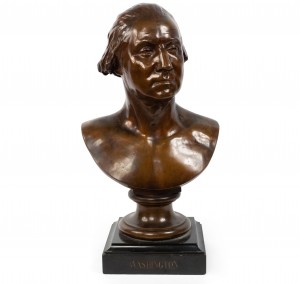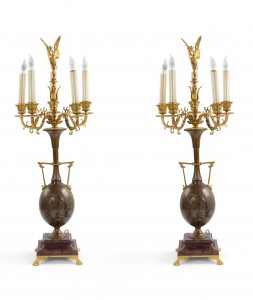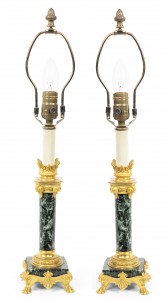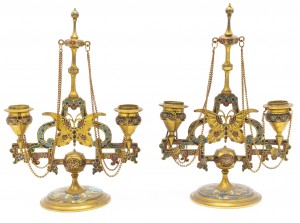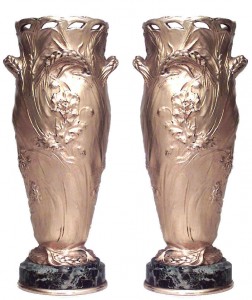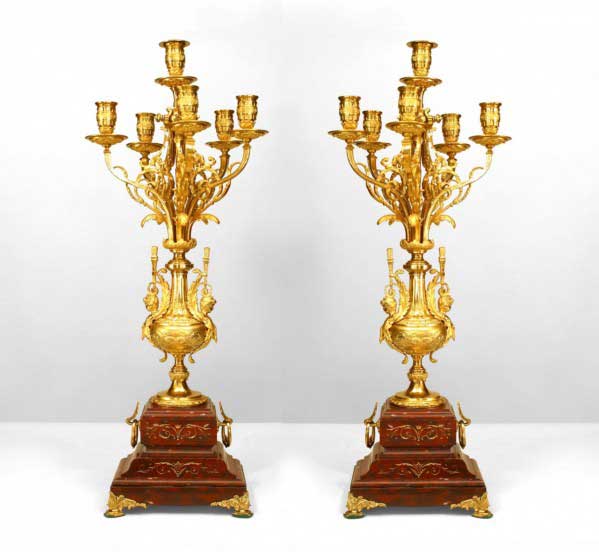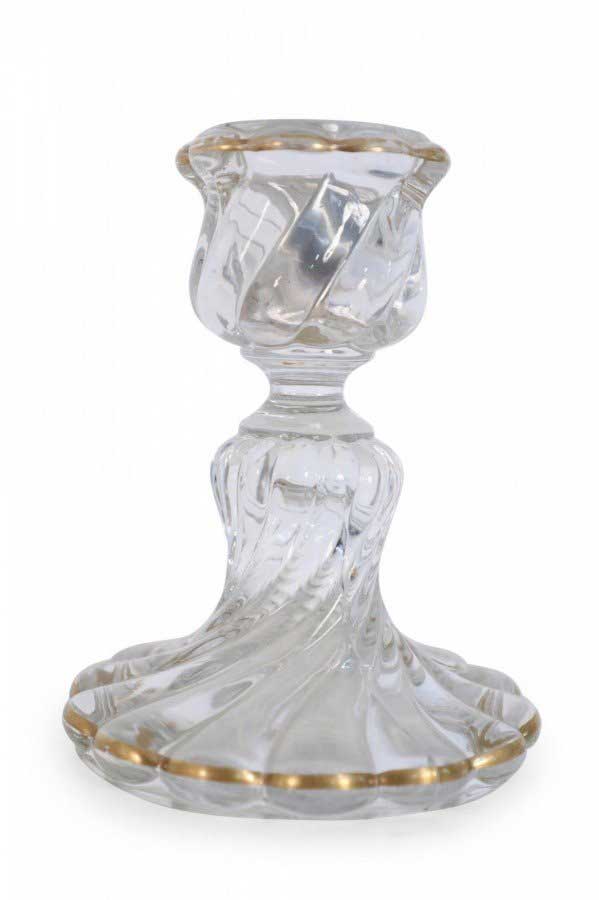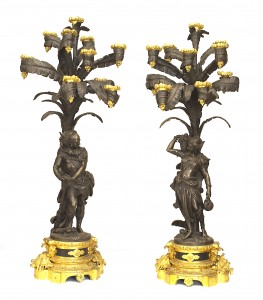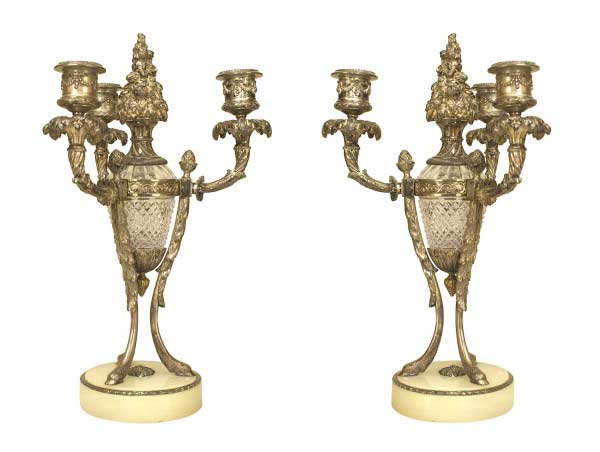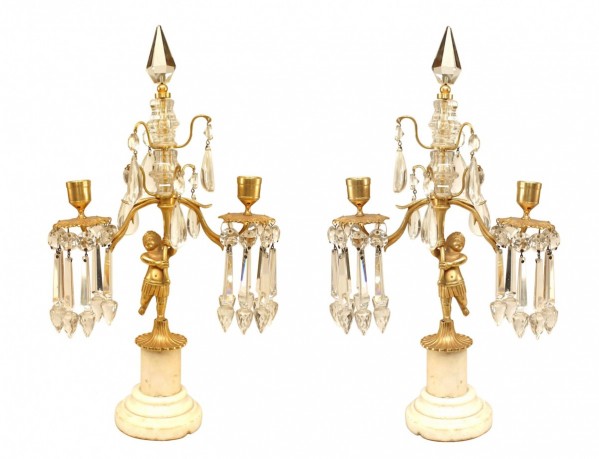Pair of French Victorian Bronze Dore Candelabras
$11,500 / Pair (USD)
Available Qty: 1
Item #: 031346
PAIR of French Victorian bronze dore and enamel double arm candelabras with butterfly design (signed F. BARBEDIENNE) (PRICED AS PAIR).
View Steven Sebring's Works at Newel (Download PDF)
Ships from:
Newel Gallery
306 East 61st Street, 3rd Floor
NY - 10065
Taxes may apply.
Learn more
See it in Person
Call (212) 758-1970 or Email Us
Pair of French Victorian Bronze Dore Candelabras
Need Assistance?
Call us at 212-758-1970 for assistance With made to order items
Special Order Terms & Conditions
50% due on approval. 50% upon completion of production. Please refer to Newel's company policies
INQUIRE
PLEASE FILL IN THE REQUIRED FIELDS.
X
Pair of French Victorian Bronze Dore Candelabras
PAIR of French Victorian bronze dore and enamel double arm candelabras with butterfly design (signed F. BARBEDIENNE) (PRICED AS PAIR)
DETAILS
Sku:
031346
Ships From:
New York, NY
Creator:
Barbedienne
DIMENSIONS (INCHES)
Height:
10.0"
INFO
Style:
French
Materials & Techniques:
Bronze, bronze dore, enamel
Category:
Accessories/Décor/Bric-a-Brac, Dining Room

About Barbedienne
The son of a goldsmith, Parisian born Antoine-Louis Barye was a sculptor of animal subjects and acclaimed, not only for his apparent skill but as the founder of what became known as the French Animaliers School. Among his patrons were representatives of the state government and royalty, including the Duke of Orleans and the Dukes of Luynes, Montpensier and Nemours.
Well compensated financially, Barye was able to buy the best of materials and hire the country's most skilled foundry craftsmen. The foundry he hired was owned by Ferdinand Barbedienne and casts from this period were stamped with the letters, FB. However, he did not make a lot of money from his work because he was such a perfectionist that often he would not sell his work because he thought it was not "quite Read Full Bio
The son of a goldsmith, Parisian born Antoine-Louis Barye was a sculptor of animal subjects and acclaimed, not only for his apparent skill but as the founder of what became known as the French Animaliers School. Among his patrons were representatives of the state government and royalty, including the Duke of Orleans and the Dukes of Luynes, Montpensier and Nemours.
Well compensated financially, Barye was able to buy the best of materials and hire the country's most skilled foundry craftsmen. The foundry he hired was owned by Ferdinand Barbedienne and casts from this period were stamped with the letters, FB. However, he did not make a lot of money from his work because he was such a perfectionist that often he would not sell his work because he thought it was not "quite right." In 1848, he declared bankruptcy and his molds and plaster casts were sold along with the copyrights. Barye's specialty was aroused, angry-seeming wild game such as lions and tigers and elephants, but he also did equestrian groups and mythology figures. In order to do realistic depictions of animal anatomy, he spent much time at the Jardin des Plantes in Paris. His early training was as an apprentice to a metal engraver, but being drafted in the army in 1812 ended that education. In 1832, he had established his studio, and unique at that time was his method of cold stamping his bronze casts so that each one had a special number. He had his first entry, The Milo of Croton, in the Paris Salon in 1819, winning a second prize. In 1831, a work regarded as a masterpiece, Tiger Devouring a Gavial, was in the Salon and purchased for the Luxembourg Gardens, which is now in the Louvre. However, many of his subsequent Salon submissions were rejected and so angered him that between 1836 and 1851, he refused to submit entries. In 1851, he again exhibited at the Salon with Jaguar Devouring A Hare, and this work, like the 1831 entry, was placed in the Luxembourg Gardens and eventually in the Louvre. In spite of problems with the Salon, Barye received many accolades for his work, and the period of 1837–48 was considered the most productive time of his career. However, in 1848, when he lost control of his work and it was reproduced by others including Martin and Barbedienne, the sculptures, according to some art professionals, are not as skillfully executed. In 1848, after his bankruptcy, Barye became director of Casts and Models in the Louvre, until 1850, when he was replaced by Emmanuel Fremiet.
Discover more of Barbedienne's extraordinary works at Newel.com, where elegance and craftsmanship meet the pinnacle of design.
more works by Barbedienne
Barbedienne Bronze Washington Bust
$35,000
(USD)
QTY: 1
#042645A
Width: 0"
Depth: 0"
Height: 25.5"
Save to project
Pair of French Louis XVI Style Ormolu and Bronze Figural Candelabras
$12,000
/ Pair (USD)
QTY: 1
#036597
Width: 10.75"
Depth: 10.5"
Height: 29.5"
Save to project
Pair of French Empire Green Marble Barbedienne Table Lamps
$12,000
/ Pair (USD)
QTY: 1
#060491
Width: 4"
Depth: 4"
Height: 22.5"
Save to project
Pair of French Victorian Bronze Dore Candelabras
$11,500
/ Pair (USD)
QTY: 1
#031346
Width: 0"
Depth: 0"
Height: 10"
Save to project
Pair of French Art Nouveau Barbedienne Bronze Dore Vases
$5,200
/ Pair (USD)
QTY: 1
#060618
Width: 3.5"
Depth: 3.5"
Height: 8"
Save to project
Pair of French Louis XVI Style Ormolu and Bronze Figural Candelabras
$12,000
/ Pair (USD)
QTY: 1
#036597
Width: 10.75"
Depth: 10.5"
Height: 29.5"
Save to project
Pair of French Empire Green Marble Barbedienne Table Lamps
$12,000
/ Pair (USD)
QTY: 1
#060491
Width: 4"
Depth: 4"
Height: 22.5"
Save to project
Pair of French Louis XVI Style Ormolu and Bronze Figural Candelabras
$12,000
/ Pair (USD)
QTY: 1
#036597
Width: 10.75"
Depth: 10.5"
Height: 29.5"
Save to project
Pair of French Empire Green Marble Barbedienne Table Lamps
$12,000
/ Pair (USD)
QTY: 1
#060491
Width: 4"
Depth: 4"
Height: 22.5"
Save to project
Pair of French Victorian Bronze Dore Candelabras
$11,500
/ Pair (USD)
QTY: 1
#031346
Width: 0"
Depth: 0"
Height: 10"
Save to project
Pair of French Art Nouveau Barbedienne Bronze Dore Vases
$5,200
/ Pair (USD)
QTY: 1
#060618
Width: 3.5"
Depth: 3.5"
Height: 8"
Save to project
Barbedienne Bronze Washington Bust
$35,000
(USD)
QTY: 1
#042645A
Width: 0"
Depth: 0"
Height: 25.5"
Save to project
Pair of French Louis XVI Style Ormolu and Bronze Figural Candelabras
$12,000
/ Pair (USD)
QTY: 1
#036597
Width: 10.75"
Depth: 10.5"
Height: 29.5"
Save to project
Pair of French Empire Green Marble Barbedienne Table Lamps
$12,000
/ Pair (USD)
QTY: 1
#060491
Width: 4"
Depth: 4"
Height: 22.5"
Save to project
Pair of French Empire Green Marble Barbedienne Table Lamps
$12,000
/ Pair (USD)
QTY: 1
#060491
Width: 4"
Depth: 4"
Height: 22.5"
Save to project
Pair of French Victorian Bronze Dore Candelabras
$11,500
/ Pair (USD)
QTY: 1
#031346
Width: 0"
Depth: 0"
Height: 10"
Save to project
Pair of French Art Nouveau Barbedienne Bronze Dore Vases
$5,200
/ Pair (USD)
QTY: 1
#060618
Width: 3.5"
Depth: 3.5"
Height: 8"
Save to project
Barbedienne Bronze Washington Bust
$35,000
(USD)
QTY: 1
#042645A
Width: 0"
Depth: 0"
Height: 25.5"
Save to project
Pair of French Louis XVI Style Ormolu and Bronze Figural Candelabras
$12,000
/ Pair (USD)
QTY: 1
#036597
Width: 10.75"
Depth: 10.5"
Height: 29.5"
Save to project
Pair of French Empire Green Marble Barbedienne Table Lamps
$12,000
/ Pair (USD)
QTY: 1
#060491
Width: 4"
Depth: 4"
Height: 22.5"
Save to project
Pair of French Victorian Bronze Dore Candelabras
$11,500
/ Pair (USD)
QTY: 1
#031346
Width: 0"
Depth: 0"
Height: 10"
Save to project
Pair of French Victorian Bronze Dore Candelabras
$11,500
/ Pair (USD)
QTY: 1
#031346
Width: 0"
Depth: 0"
Height: 10"
Save to project
Pair of French Art Nouveau Barbedienne Bronze Dore Vases
$5,200
/ Pair (USD)
QTY: 1
#060618
Width: 3.5"
Depth: 3.5"
Height: 8"
Save to project
Barbedienne Bronze Washington Bust
$35,000
(USD)
QTY: 1
#042645A
Width: 0"
Depth: 0"
Height: 25.5"
Save to project
Pair of French Louis XVI Style Ormolu and Bronze Figural Candelabras
$12,000
/ Pair (USD)
QTY: 1
#036597
Width: 10.75"
Depth: 10.5"
Height: 29.5"
Save to project
Pair of French Empire Green Marble Barbedienne Table Lamps
$12,000
/ Pair (USD)
QTY: 1
#060491
Width: 4"
Depth: 4"
Height: 22.5"
Save to project
Pair of French Victorian Bronze Dore Candelabras
$11,500
/ Pair (USD)
QTY: 1
#031346
Width: 0"
Depth: 0"
Height: 10"
Save to project
Pair of French Art Nouveau Barbedienne Bronze Dore Vases
$5,200
/ Pair (USD)
QTY: 1
#060618
Width: 3.5"
Depth: 3.5"
Height: 8"
Save to project
Pair of French Art Nouveau Barbedienne Bronze Dore Vases
$5,200
/ Pair (USD)
QTY: 1
#060618
Width: 3.5"
Depth: 3.5"
Height: 8"
Save to project
Barbedienne Bronze Washington Bust
$35,000
(USD)
QTY: 1
#042645A
Width: 0"
Depth: 0"
Height: 25.5"
Save to project
Pair of French Louis XVI Style Ormolu and Bronze Figural Candelabras
$12,000
/ Pair (USD)
QTY: 1
#036597
Width: 10.75"
Depth: 10.5"
Height: 29.5"
Save to project
Pair of French Empire Green Marble Barbedienne Table Lamps
$12,000
/ Pair (USD)
QTY: 1
#060491
Width: 4"
Depth: 4"
Height: 22.5"
Save to project
Pair of French Victorian Bronze Dore Candelabras
$11,500
/ Pair (USD)
QTY: 1
#031346
Width: 0"
Depth: 0"
Height: 10"
Save to project
Pair of French Art Nouveau Barbedienne Bronze Dore Vases
$5,200
/ Pair (USD)
QTY: 1
#060618
Width: 3.5"
Depth: 3.5"
Height: 8"
Save to project
Barbedienne Bronze Washington Bust
$35,000
(USD)
QTY: 1
#042645A
Width: 0"
Depth: 0"
Height: 25.5"
Save to project
related items
Pair of French Victorian Rouge Marble and Bronze Candelabra
$12,500
/ Set (USD)
QTY: 1
#JDB070A
Width: 18.75"
Depth: 9"
Height: 24"
Save to project
French Victorian Style Crystal Candlestick
$600
(USD)
QTY: 1
#SIL174
Width: 5.5"
Depth: 5.5"
Height: 8.5"
Save to project
Pair of French Napoleon III Bronze Figural Candelabras
$37,500
/ Pair (USD)
QTY: 1
#REG3872
Width: 14.5"
Depth: 14.5"
Height: 37.75"
Save to project
Pair of French Victorian Style Bronze and Glass Candelabras
$6,000
/ Pair (USD)
QTY: 1
#REG3849
Width: 8"
Depth: 8"
Height: 12.75"
Save to project
Pair of French Victorian Gilt Bronze and Crystal Candelabras
$4,500
/ Pair (USD)
QTY: 1
#PPL098
Width: 8.5"
Depth: 3.5"
Height: 16.5"
Save to project
French Victorian Style Crystal Candlestick
$600
(USD)
QTY: 1
#SIL174
Width: 5.5"
Depth: 5.5"
Height: 8.5"
Save to project
Pair of French Napoleon III Bronze Figural Candelabras
$37,500
/ Pair (USD)
QTY: 1
#REG3872
Width: 14.5"
Depth: 14.5"
Height: 37.75"
Save to project
French Victorian Style Crystal Candlestick
$600
(USD)
QTY: 1
#SIL174
Width: 5.5"
Depth: 5.5"
Height: 8.5"
Save to project
Pair of French Napoleon III Bronze Figural Candelabras
$37,500
/ Pair (USD)
QTY: 1
#REG3872
Width: 14.5"
Depth: 14.5"
Height: 37.75"
Save to project
Pair of French Victorian Style Bronze and Glass Candelabras
$6,000
/ Pair (USD)
QTY: 1
#REG3849
Width: 8"
Depth: 8"
Height: 12.75"
Save to project
Pair of French Victorian Gilt Bronze and Crystal Candelabras
$4,500
/ Pair (USD)
QTY: 1
#PPL098
Width: 8.5"
Depth: 3.5"
Height: 16.5"
Save to project
Pair of French Victorian Rouge Marble and Bronze Candelabra
$12,500
/ Set (USD)
QTY: 1
#JDB070A
Width: 18.75"
Depth: 9"
Height: 24"
Save to project
French Victorian Style Crystal Candlestick
$600
(USD)
QTY: 1
#SIL174
Width: 5.5"
Depth: 5.5"
Height: 8.5"
Save to project
Pair of French Napoleon III Bronze Figural Candelabras
$37,500
/ Pair (USD)
QTY: 1
#REG3872
Width: 14.5"
Depth: 14.5"
Height: 37.75"
Save to project
Pair of French Napoleon III Bronze Figural Candelabras
$37,500
/ Pair (USD)
QTY: 1
#REG3872
Width: 14.5"
Depth: 14.5"
Height: 37.75"
Save to project
Pair of French Victorian Style Bronze and Glass Candelabras
$6,000
/ Pair (USD)
QTY: 1
#REG3849
Width: 8"
Depth: 8"
Height: 12.75"
Save to project
Pair of French Victorian Gilt Bronze and Crystal Candelabras
$4,500
/ Pair (USD)
QTY: 1
#PPL098
Width: 8.5"
Depth: 3.5"
Height: 16.5"
Save to project
Pair of French Victorian Rouge Marble and Bronze Candelabra
$12,500
/ Set (USD)
QTY: 1
#JDB070A
Width: 18.75"
Depth: 9"
Height: 24"
Save to project
French Victorian Style Crystal Candlestick
$600
(USD)
QTY: 1
#SIL174
Width: 5.5"
Depth: 5.5"
Height: 8.5"
Save to project
Pair of French Napoleon III Bronze Figural Candelabras
$37,500
/ Pair (USD)
QTY: 1
#REG3872
Width: 14.5"
Depth: 14.5"
Height: 37.75"
Save to project
Pair of French Victorian Style Bronze and Glass Candelabras
$6,000
/ Pair (USD)
QTY: 1
#REG3849
Width: 8"
Depth: 8"
Height: 12.75"
Save to project
Pair of French Victorian Style Bronze and Glass Candelabras
$6,000
/ Pair (USD)
QTY: 1
#REG3849
Width: 8"
Depth: 8"
Height: 12.75"
Save to project
Pair of French Victorian Gilt Bronze and Crystal Candelabras
$4,500
/ Pair (USD)
QTY: 1
#PPL098
Width: 8.5"
Depth: 3.5"
Height: 16.5"
Save to project
Pair of French Victorian Rouge Marble and Bronze Candelabra
$12,500
/ Set (USD)
QTY: 1
#JDB070A
Width: 18.75"
Depth: 9"
Height: 24"
Save to project
French Victorian Style Crystal Candlestick
$600
(USD)
QTY: 1
#SIL174
Width: 5.5"
Depth: 5.5"
Height: 8.5"
Save to project
Pair of French Napoleon III Bronze Figural Candelabras
$37,500
/ Pair (USD)
QTY: 1
#REG3872
Width: 14.5"
Depth: 14.5"
Height: 37.75"
Save to project
Pair of French Victorian Style Bronze and Glass Candelabras
$6,000
/ Pair (USD)
QTY: 1
#REG3849
Width: 8"
Depth: 8"
Height: 12.75"
Save to project
Pair of French Victorian Gilt Bronze and Crystal Candelabras
$4,500
/ Pair (USD)
QTY: 1
#PPL098
Width: 8.5"
Depth: 3.5"
Height: 16.5"
Save to project
Pair of French Victorian Gilt Bronze and Crystal Candelabras
$4,500
/ Pair (USD)
QTY: 1
#PPL098
Width: 8.5"
Depth: 3.5"
Height: 16.5"
Save to project
Pair of French Victorian Rouge Marble and Bronze Candelabra
$12,500
/ Set (USD)
QTY: 1
#JDB070A
Width: 18.75"
Depth: 9"
Height: 24"
Save to project
French Victorian Style Crystal Candlestick
$600
(USD)
QTY: 1
#SIL174
Width: 5.5"
Depth: 5.5"
Height: 8.5"
Save to project
Pair of French Napoleon III Bronze Figural Candelabras
$37,500
/ Pair (USD)
QTY: 1
#REG3872
Width: 14.5"
Depth: 14.5"
Height: 37.75"
Save to project
Pair of French Victorian Style Bronze and Glass Candelabras
$6,000
/ Pair (USD)
QTY: 1
#REG3849
Width: 8"
Depth: 8"
Height: 12.75"
Save to project
Pair of French Victorian Gilt Bronze and Crystal Candelabras
$4,500
/ Pair (USD)
QTY: 1
#PPL098
Width: 8.5"
Depth: 3.5"
Height: 16.5"
Save to project
Pair of French Victorian Rouge Marble and Bronze Candelabra
$12,500
/ Set (USD)
QTY: 1
#JDB070A
Width: 18.75"
Depth: 9"
Height: 24"












